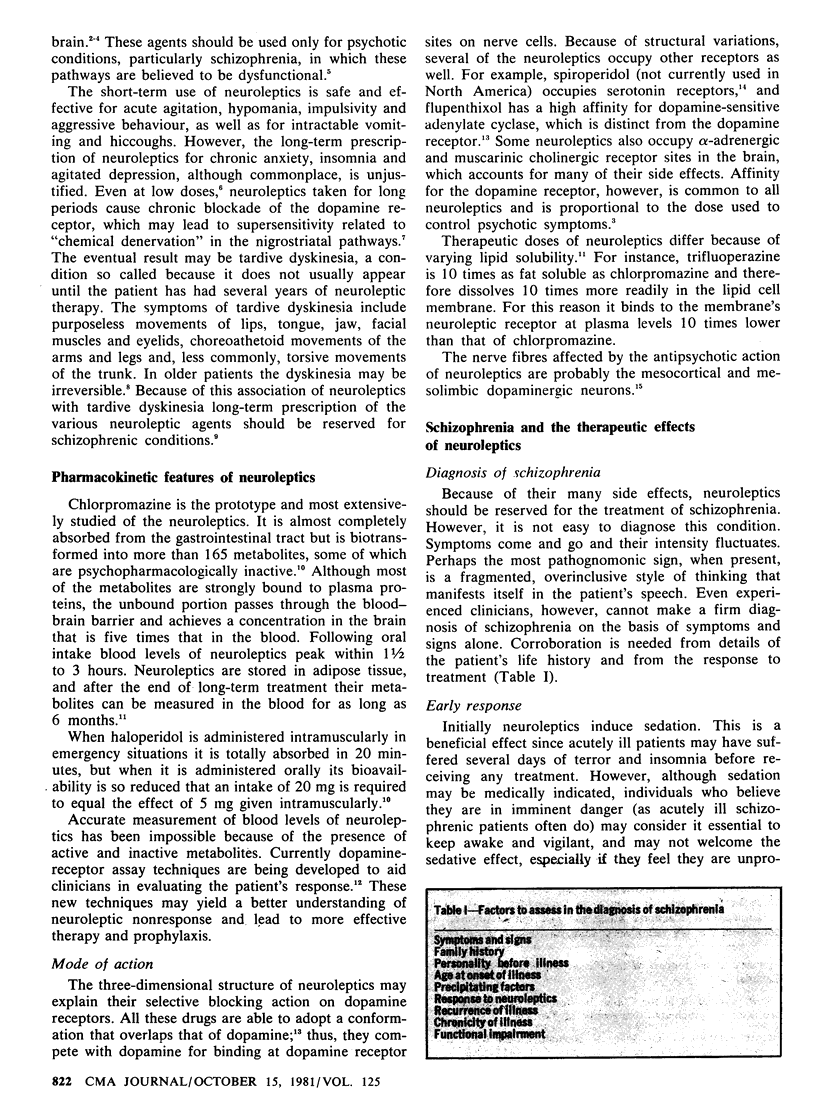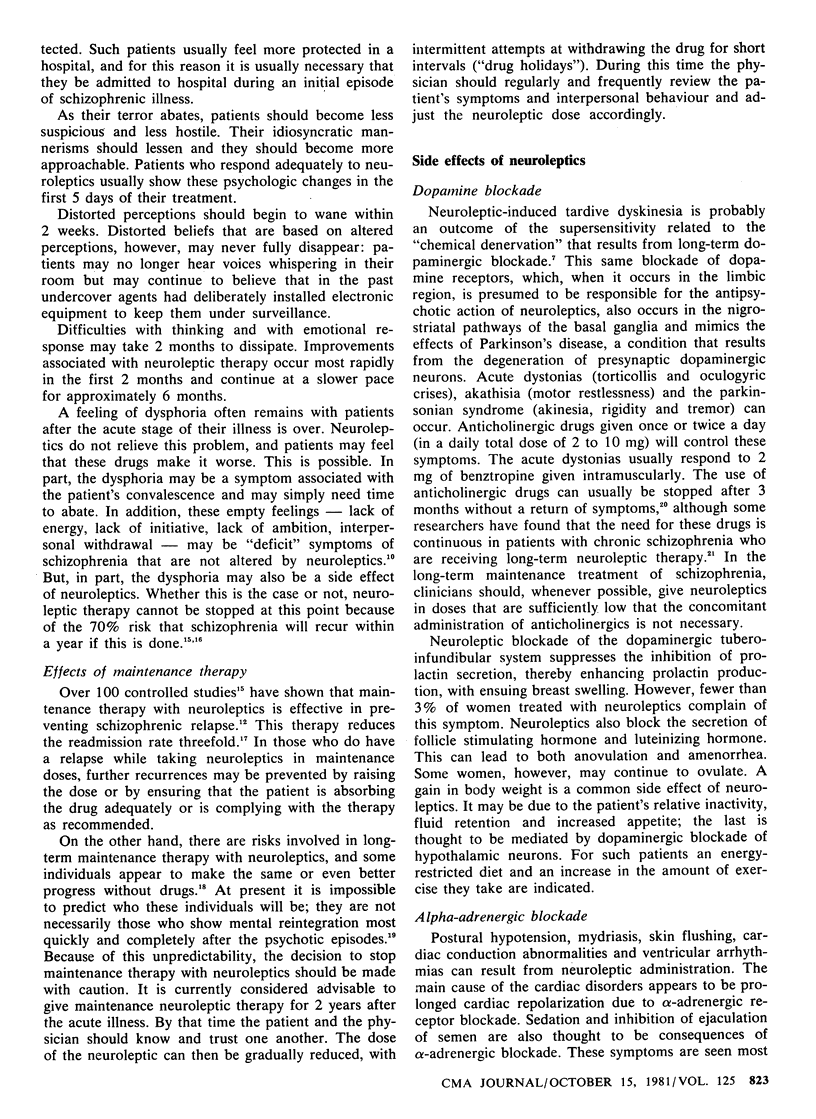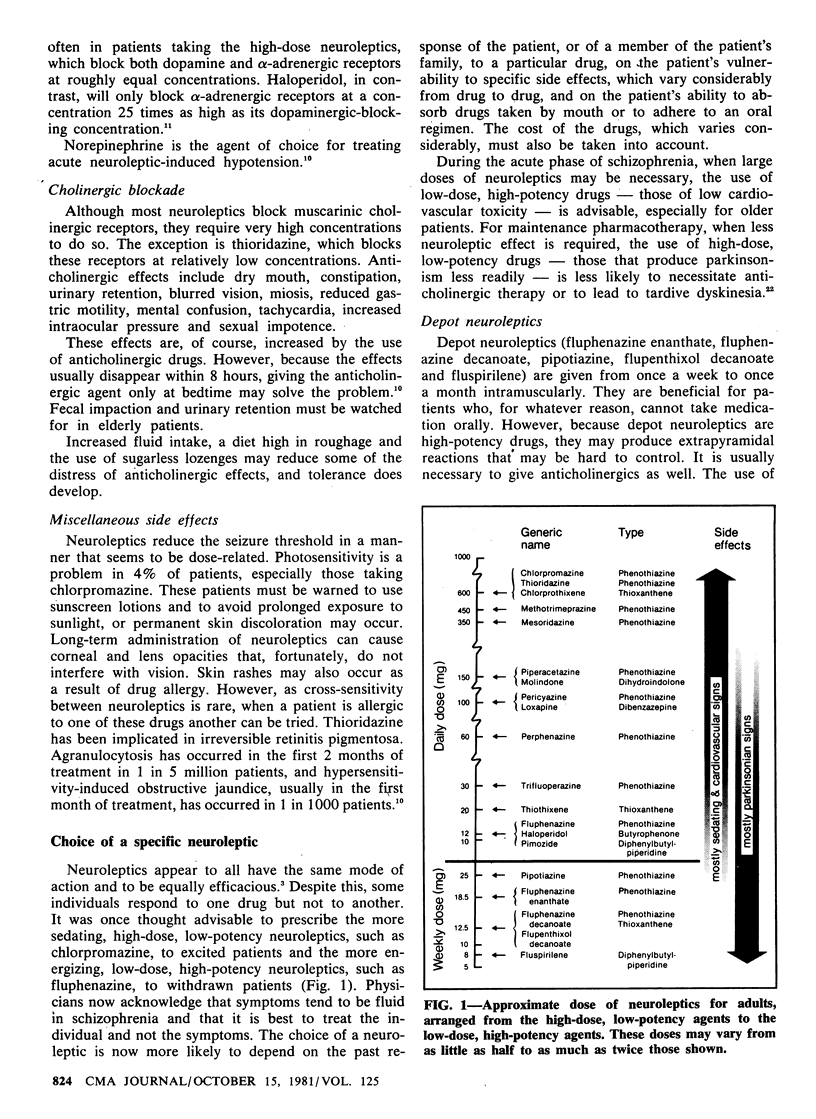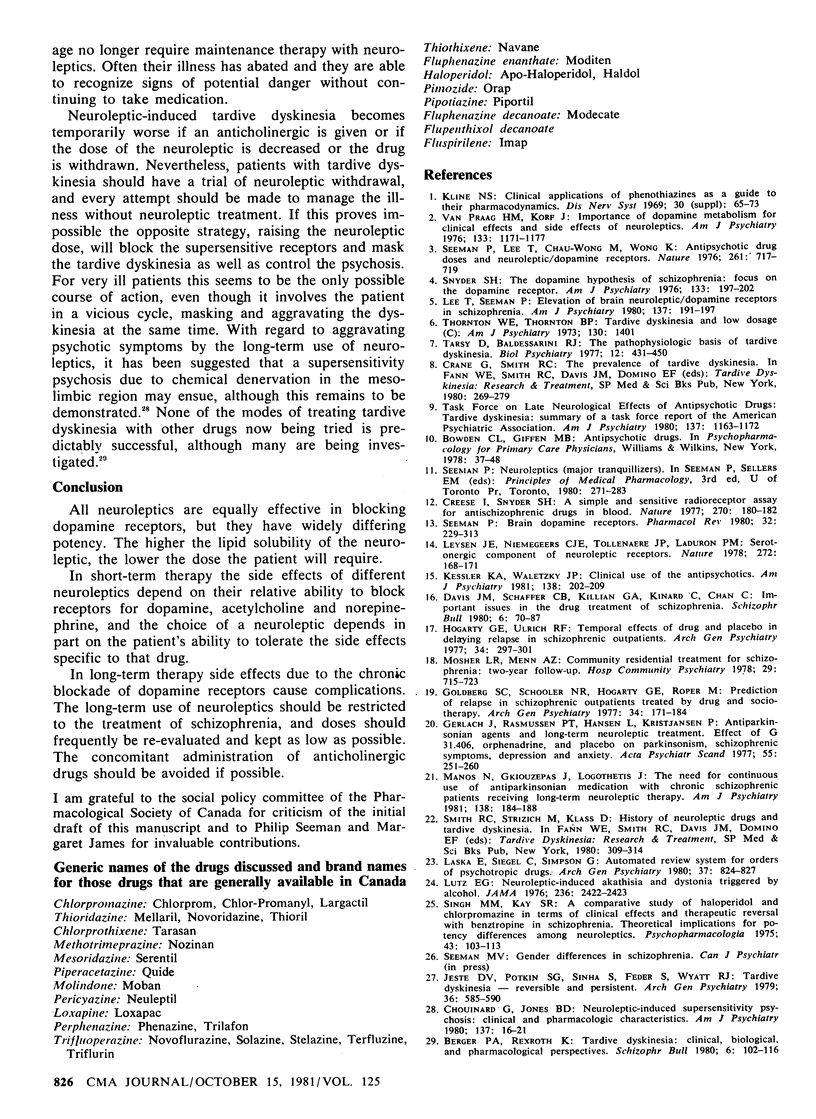Abstract
Neuroleptic drugs reduce the severity and prevent the recurrence of symptoms of schizophrenia. Recent studies indicate that these drugs probably produce their antipsychotic effects by blocking dopamine receptors in the brain, although they also block acetylcholine and norepinephrine receptors. The potency of commercially available neuroleptics in blocking dopamine receptors varies widely, being related to the compound's lipid solubility. Neuroleptics predispose the patient to short-term and long-term medical hazards that must be weighed against the benefits of reduced symptom intensity, shortened psychotic episodes and lessened likelihood of recurrence of acute schizophrenic epidoses. The side effects associated with short-term therapy are either extremely rare or are treatable by dose change, medication change or the use of additional drugs. In long-term therapy the risks are more problematic in that they are sometimes irreversible. These include tardive dyskinesia, skin discoloration and corneal deposits. The clinician must consider the pattern aand severity of each patient's present and past psychotic episodes before deciding whether maintenance therapy with neuroleptics is justified. If it is, doses should be re-evaluated frequently and kept as low as possible. Concomitant administration of anticholinergic agents should be avoided if possible. Most important, the long-term administration of neuroleptics should be prescribed only for patients with schizophrenia and not for those with conditions that respond to other treatments.
Full text
PDF





Selected References
These references are in PubMed. This may not be the complete list of references from this article.
- Berger P. A., Rexroth K. Tardive dyskinesia: clinical, biological, and pharmacological perspectives. Schizophr Bull. 1980;6(1):102–116. doi: 10.1093/schbul/6.1.102. [DOI] [PubMed] [Google Scholar]
- Chouinard G., Jones B. D. Neuroleptic-induced supersensitivity psychosis: clinical and pharmacologic characteristics. Am J Psychiatry. 1980 Jan;137(1):16–21. doi: 10.1176/ajp.137.1.16. [DOI] [PubMed] [Google Scholar]
- Creese I., Snyder S. H. A simple and sensitive radioreceptor assay for antischizophrenic drugs in blood. Nature. 1977 Nov 10;270(5633):180–182. doi: 10.1038/270180a0. [DOI] [PubMed] [Google Scholar]
- Davis J. M., Schaffer C. B., Killian G. A., Kinard C., Chan C. Important issues in the drug treatment of schizophrenia. Schizophr Bull. 1980;6(1):70–87. doi: 10.1093/schbul/6.1.70. [DOI] [PubMed] [Google Scholar]
- Gerlach J., Rasmussen P. T., Hansen L., Kristjansen P. Antiparkinsonian agents and long-term neuroleptic treatment. Effect of G 31.406, orphenadrine, and placebo on parkinsonism, schizophrenic symptoms, depression and anxiety. Acta Psychiatr Scand. 1977 Apr;55(4):251–260. doi: 10.1111/j.1600-0447.1977.tb00170.x. [DOI] [PubMed] [Google Scholar]
- Goldberg S. C., Schooler N. R., Hogarty G. E., Roper M. Prediction of relapse in schizophrenic outpatients treated by drug and sociotherapy. Arch Gen Psychiatry. 1977 Feb;34(2):171–184. doi: 10.1001/archpsyc.1977.01770140061008. [DOI] [PubMed] [Google Scholar]
- Hogarty G. E., Ulrich R. F. Temporal effects of drug and placebo in delaying relapse in schizophrenic outpatients. Arch Gen Psychiatry. 1977 Mar;34(3):297–301. doi: 10.1001/archpsyc.1977.01770150055005. [DOI] [PubMed] [Google Scholar]
- Jeste D. V., Potkin S. G., Sinha S., Feder S., Wyatt R. J. Tardive dyskinesia--reversible and persistent. Arch Gen Psychiatry. 1979 May;36(5):585–590. doi: 10.1001/archpsyc.1979.01780050095012. [DOI] [PubMed] [Google Scholar]
- Kessler K. A., Waletzky J. P. Clinical use of the antipsychotics. Am J Psychiatry. 1981 Feb;138(2):202–209. doi: 10.1176/ajp.138.2.202. [DOI] [PubMed] [Google Scholar]
- Kline N. S. Clinical applications of phenothiazines as a guide to their pharmacodynamics. Dis Nerv Syst. 1969 Feb;30(2 Suppl):65–73. [PubMed] [Google Scholar]
- Laska E., Siegel C., Simpson G. Automated review system for orders of psychotropic drugs. Arch Gen Psychiatry. 1980 Jul;37(7):824–827. doi: 10.1001/archpsyc.1980.01780200102013. [DOI] [PubMed] [Google Scholar]
- Lee T., Seeman P. Elevation of brain neuroleptic/dopamine receptors in schizophrenia. Am J Psychiatry. 1980 Feb;137(2):191–197. doi: 10.1176/ajp.137.2.191. [DOI] [PubMed] [Google Scholar]
- Leysen J. E., Niemegeers C. J., Tollenaere J. P., Laduron P. M. Serotonergic component of neuroleptic receptors. Nature. 1978 Mar 9;272(5649):168–171. doi: 10.1038/272168a0. [DOI] [PubMed] [Google Scholar]
- Lutz E. G. Neuroleptic-induced akathisia and dystonia triggered by alcohol. JAMA. 1976 Nov 22;236(21):2422–2423. [PubMed] [Google Scholar]
- Manos N., Gkiouzepas J., Logothetis J. The need for continuous use of antiparkinsonian medication with chronic schizophrenic patients receiving long-term neuroleptic therapy. Am J Psychiatry. 1981 Feb;138(2):184–188. doi: 10.1176/ajp.138.2.184. [DOI] [PubMed] [Google Scholar]
- Mosher L. R., Menn A. Z. Community residential treatment for schizophrenia: two-year follow-up. Hosp Community Psychiatry. 1978 Nov;29(11):715–723. doi: 10.1176/ps.29.11.715. [DOI] [PubMed] [Google Scholar]
- Seeman P., Lee T., Chau-Wong M., Wong K. Antipsychotic drug doses and neuroleptic/dopamine receptors. Nature. 1976 Jun 24;261(5562):717–719. doi: 10.1038/261717a0. [DOI] [PubMed] [Google Scholar]
- Singh M. M., Kay S. R. A comparative study of haloperidol and chlorpromazine in terms of clinical effects and therapeutic reversal with benztropine in schizophrenia. Theoretical implications for potency differences among neuroleptics. Psychopharmacologia. 1975 Aug 21;43(2):103–113. doi: 10.1007/BF00421012. [DOI] [PubMed] [Google Scholar]
- Snyder S. H. The dopamine hypothesis of schizophrenia: focus on the dopamine receptor. Am J Psychiatry. 1976 Feb;133(2):197–202. doi: 10.1176/ajp.133.2.197. [DOI] [PubMed] [Google Scholar]
- Tarsy D., Baldessarini R. J. The pathophysiologic basis of tardive dyskinesia. Biol Psychiatry. 1977 Jun;12(3):431–450. [PubMed] [Google Scholar]
- Thornton W. E., Thornton B. P. Letter: Tardive dyskinesia and low dosage. Am J Psychiatry. 1973 Dec;130(12):1401–1401. doi: 10.1176/ajp.130.12.1401. [DOI] [PubMed] [Google Scholar]
- Van Praag H. M., Korf J. Importance of dopamine metabolism for clinical effects and side effects of neuroleptics. Am J Psychiatry. 1976 Oct;133(10):1171–1177. doi: 10.1176/ajp.133.10.1171. [DOI] [PubMed] [Google Scholar]


